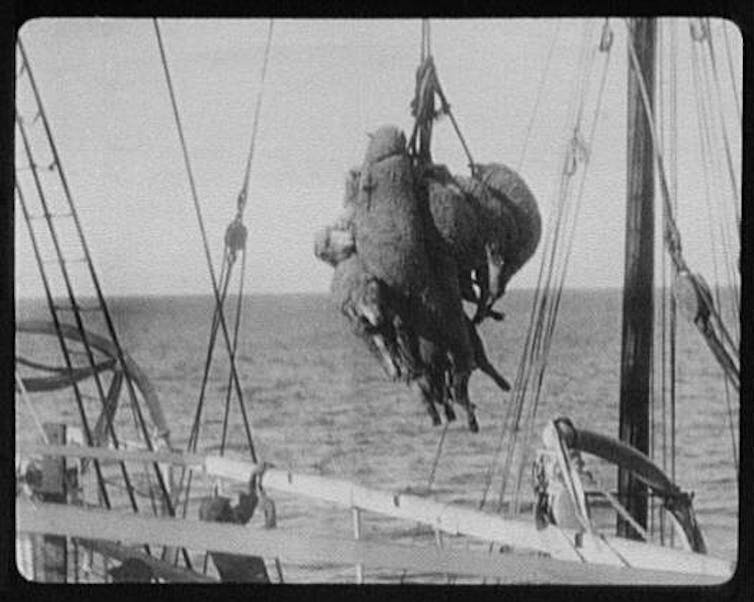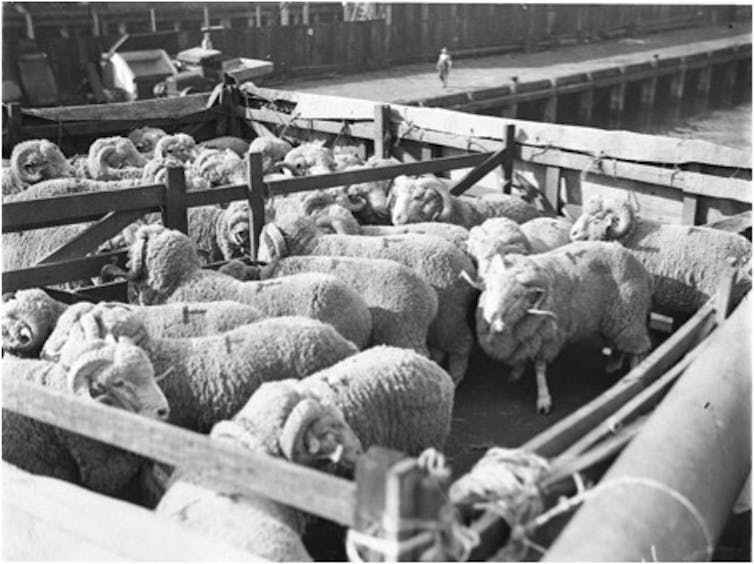Australia's history of live exports is more than two centuries old
- Written by Nancy Cushing, Associate professor, University of Newcastle
A recent episode of 60 Minutes has captured public attention and the political agenda by airing dramatic video footage from Animals Australia, showing the fate of Australian animals in the live export trade.
Video shot secretly by a crew member shows sheep on five separate voyages from Fremantle to the Middle East last year. They are buffeted by the movement of the ship, strain to breathe in the hot, noisy and acrid atmosphere between decks and trample the dead and dying under their hooves.
But while these glimpses inside a transport ship are new, the practice of live animal export is as old as the European colonisation of Australia.
Read more: Can live animal export ever be humane?
Animals of the new colony
The first arrival of animals that would later be exported from Australia, including sheep, cattle and goats, can be dated with unusual precision to January 1788.
Like the convict workforce who made up the bulk of the human cargo on the First Fleet, the livestock, purchased mainly at the Cape of Good Hope, were considered necessary to transplant a British society and economy in Antipodean soil. Live animal import from other colonies, like India and Batavia, and from Europe continued throughout the first century of colonisation.
 Hoists were used to load and unload live animals in ports without purpose-built ramps. This photograph demonstrates the practice in India in 1895.
Source: William Henry Jackson, World’s Transportation Commission photograph collection. Library of Congress
Hoists were used to load and unload live animals in ports without purpose-built ramps. This photograph demonstrates the practice in India in 1895.
Source: William Henry Jackson, World’s Transportation Commission photograph collection. Library of Congress
Breeds that suited the climate and their roles in the colony, especially those that helped displace native plants and animals and Indigenous peoples, were sought after and carefully nurtured.
Gradually the inward flow of animals reversed. Flocks and herds increased to the point where some could be sold on to other destinations. Initially, this was to the other colonies Britain was establishing in the region, such as Van Diemen’s Land (now Tasmania), Western Australia, New Zealand and South Australia. These animals were primarily traded to establish new populations at their destinations.
Animals from New South Wales were also sent to the French colony of New Caledonia, and in small numbers farther afield to Russia, Japan and India. As numbers rose, larger-scale live export for consumption became established.
A hidden process
As in the present, this trade had distinct phases, some more visible than others. The process began where the animals were raised, generally on lightly stocked rangelands in the interior. They were driven on foot or loaded onto rail carriages to be taken to ports, where they waited in open yards to be loaded onto ships.
Thus far, the animals were moving through public spaces, where their treatment and conditions could be seen and in some cases recorded. Members of the public could register their concerns and seek to have mistreatment addressed. And even in a period when animal welfare was still an emerging concept, some did.
Railcars laden with frightened stock led to complaints about overcrowding and lack of access to food and water. One observer labelled such treatment “as gross a case of cruelty as it is possible to conceive”.
However, once the animals were hoisted or walked onto ships, they became invisible. No outsider could see them. Only those involved with the voyage knew how densely they were packed, how secure their pens were, whether their dung was cleared away, or how much food and water they received over journeys that could last for weeks. In the case of sheep, the advice was to pack them like wool bales, so tightly pressed together that they prevented one another from falling over.
In many cases, the animals were barely seen at all, except by one another, being left to their own devices on short voyages. During longer trips they would be tended to minimally, because of the toxic environment created below deck by what were termed their “exhalations of carbonic gases”.
Even the evidence of how many died on the voyages was hidden. Their bodies were thrown overboard before reaching port and few records were kept.
Animals carried on open decks could be seen while at the docks and had access to better-quality air, but were more vulnerable to high seas and inclement weather.
 Animals carried on open decks could be seen while at the docks and had access to better-quality air, but were also vulnerable to high seas and inclement weather. Sheep in pens on a ship’s deck, Sydney Harbour, circa 1929.
Sam Hood photograph, State Library of New South Wales, Home and Away, 4066.
Animals carried on open decks could be seen while at the docks and had access to better-quality air, but were also vulnerable to high seas and inclement weather. Sheep in pens on a ship’s deck, Sydney Harbour, circa 1929.
Sam Hood photograph, State Library of New South Wales, Home and Away, 4066.
At the other end of the journey, the exported animals came back into view. This was often when the most useful accounts were recorded. Complaints about their poor condition, reduced numbers or the loss of entire shipments of animals were considered worthy of writing about in local newspapers by those who had eagerly awaited their arrival. It is at the receiving end of the export process that accusations of flimsy pens, overcrowding or the loading of animals that were not fit for the voyage can be found.
Taking this longer view of the Australian live export trade shows just how extraordinary the opportunity to see what happens during live export is. Animals Australia has noted that “Australia’s live sheep trade has operated for over five decades with only those financially invested in the trade having visual access to the conditions and welfare implications for the sheep on-board”.
Read more: Assessing Australia’s regulation of live animal exports
This has been an issue for much longer than 50 years, but it’s now possible for outsiders – including farmers, politicians and members of the public – to see the appalling conditions of the live export trade for themselves.
This article is based on a blog post originally published by White Horse Press.
Authors: Nancy Cushing, Associate professor, University of Newcastle
Read more http://theconversation.com/australias-history-of-live-exports-is-more-than-two-centuries-old-94730





